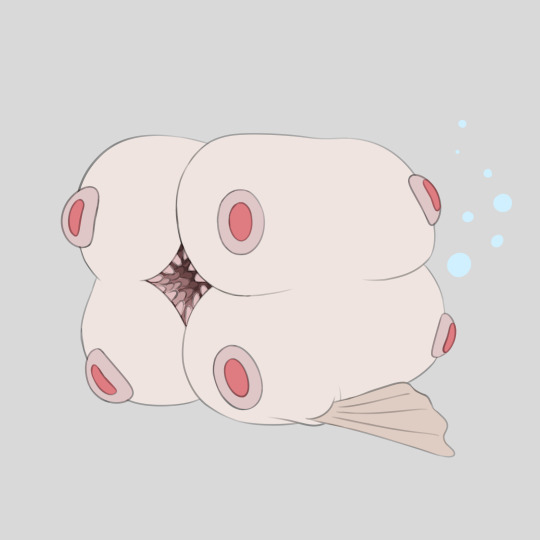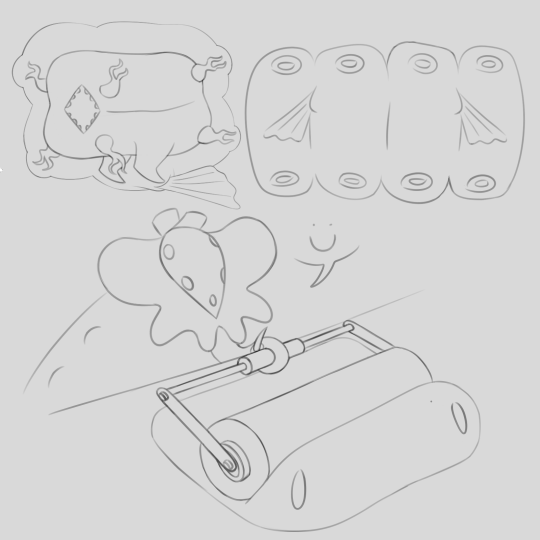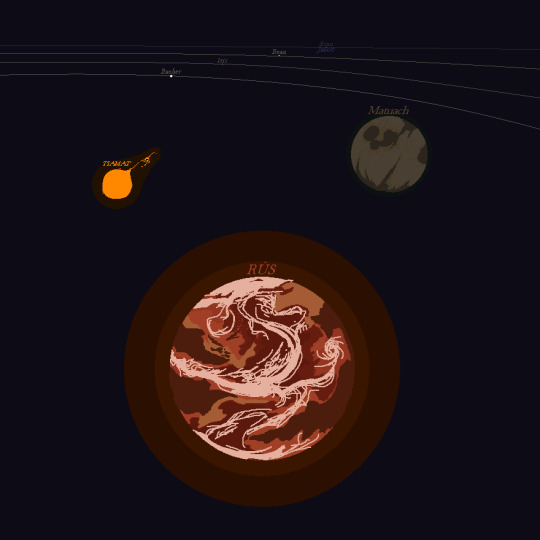Don't wanna be here? Send us removal request.
Text

While some amount of eye floaters is considered normal, an excess may be the first sign of colonization by the Floater Jellyfish, Tripedalia miodesopsia. While mostly harmless, these tiny cnidarians can multiply over time and cause visual impairments.
Infection occurs when a damaged or irritated eye contacts water carrying their microscopic larvae, but the first signs may take years to start appearing.

In an environment without predators, this jellyfish has lost the ability to sting, and its life cycle has slowed down to avoid taking up all the limited resources in the eye. It generally infects fish eyes, where it will wait to be consumed by a larger fish to continue its life cycle. In human infections, this cycle is severed, and the jellyfish might end up overcrowding the vitreous body.
2K notes
·
View notes
Text




An example of megaplat clothing.
The creature above, I'll call it the assfish, is a marine creature that survives by floating aimlessly through the water and filter feeding anything that lies in its path. It seems like an easy target for predators, but its thick skin prevents any predator from harming it too badly. This method of survival has been turned against them however, as their skin is the most common material for clothing among the megaplat, to the point where they were domesticated and farmed for it. The skin is peeled off the unsightly beast, then it is flattened and stretched out until it is wide enough to cover an adult megaplat, but also thin and light enough that it doesn't smother the megaplat's own skin. The skin is then cut into a proper cloak, with the corners being used for straps, and the leftover material being used to the wearer's liking. The plat in this example has opted to turn their leftovers into a fancy lining for the base of the cloak.
#original species#spec bio#speculative biology#xenobiology#alien culture#alien species#worldbuilding
9 notes
·
View notes
Text
Anatomy of the Megaloplaty

Red - Eyes - Seen here are the muscles required to move the eyes when emoting, which are connected and controlled by the two central muscles in the middle. The muscles contain nerves that get connected at these center points and lined to the brain, allowing the megaplat to see.
Pink - Brain - The brain is rather big, making the megaplat very intelligent, but unlike our brains, it doesn't have folds. Think of a music record: the shape of its grooves retains the information required to play music- this brain works similarly. The hair-thin grooves store memories and everything the megaplat needs to know in order to survive.
Orange - Liquid feeder - The proboscis stabs prey and its blood is sucked up through the trunk and processed in a specialized chamber. This chamber holds the blood and rids it of waste, and once it's all purified, it gets drained into the stomach.
Green - Solid feeder/digestive system - Flesh is inserted into the mouth, and the muscle lining the esophagus contracts and causes the teeth to scrape against and break the flesh down. The mushy flesh is then pushed through the three stomachs and processed into waste.
Yellow - Reproductive system - The megaplat is hermaphroditic. If they're impregnated, they produce eggs that remain stored in the uterus until they're just ready to hatch. The megaplat lacks a penis of any sort, so if they're doing the impregnating, the sperm travels up the body and through the trunk, and when they're ready they stab their partner in the butt with their proboscis. This inserts the sperm into their partner's uterus and gets them pregnant. egg pregnant.
Light blue - Stink sack - When the megaplat feels threatened, they release a foul odor to deter whatever's threatening it. However, the sack can't dispel odor itself, only make it. It's blown out of the sack by the lung, which is connected through a tube.
Dark blue - Lung - Just one big lung. It's so big that the megaplat can hold their breath for 4-6 earth hours. The air diffuses outward from the lungs to the rest of the body through specialized vessels, and the waste is dispersed out through pores in the skin. When a megaplat is underwater long enough, they'll become covered in many tiny waste bubbles.
Purple - Muscles - Just below the skin is another "skin," however it's actually all muscle. This muscle layer allows the megaplat to move their body in ways that aid with locomotion on land and in the sea. The main muscle is on the belly, It's the biggest and helps the most with movement.
#spec bio#speculative biology#speculative zoology#alien species#original species#anatomy#alien anatomy
13 notes
·
View notes
Text

The Tiamat Solar System, home to Rûs, Matuach, Bacher, Iris, Bean, Esau, and Jacob, in order of proximity.
The central star, Tiamat, is a K-Class star that has recently come into contact with a small black hole that has begun the process of consumption. Naturally, this isn't very good for the planet Rûs, the closest of the bunch, and especially not good for all of the life that lives on it.
Rûs is a mars sized planet with large amounts of tectonic activity and a large dusty orange atmosphere. The planet has a rusty color to it due to the red color of its plants as well as the aforementioned dusty atmosphere, which inspired the name. Rûs is also home to a sapient species (or two) that I'll dive into more detail on later, and they'll have to deal with not having their planet or star destroyed eventually.
#I love how the last few planets are faint little dots#it really portrays just how monumental solar systems are#other worlds#i did not put this on the wrong blog it was merely an illusion. one of my various wizard tricks
15 notes
·
View notes
Text
Planet Minthe


Terrain - The planet is blanketed in a vast, but shallow ocean. Due to tectonic plates crushing up against/sliding over each other, Mountains formed and became islands There's one major and one minor mountain range. Islands vary massively in size, from being as small as a couch to as big as a continent
Climate - Warm and humid pretty much everywhere. Very cloudy all of the time, but occasionally the clouds break and reveal the sun. Fog and rain are common occurrences. Rain varies from light showers to torrential downpours.
Flora - Most flora is similar to kelp (when underwater) or moss (when on land). Both kelp and moss can grow into dense forests. Moss forests are so dense that they're more like caverns, it's just easier to carve out new paths since it's plant matter instead of hard stone. Kelp forests, while dense, are easier to pass through because kelp is sleek and simply glides of the skin of most fauna.
Fauna - Varies widely between islands, but most of them have a few things in common: A uni-eye, with multiple pupils that can switch position depending on the situation - Smooth skin that has to stay moist to function properly, which arose as a result of the climate - and appendages for liquid feeding. About 75% of species on Minthe incorporate some sort of liquid into their diet, and 10% rely solely on liquids.
The Greater Flatworm, Megaloplaty

Appearance - A big tube with flaps near the bottom of the body and around the uni-eye. The body flaps are good for both swimming and crawling around on land, and the eye flaps, let's call them "ears," are very good at detecting vibrational changes in the water and air. The Megaplat has a small trunk that stays tucked in their mouth and is pulled out when it's time to feed. They have six holes on their back which connect to the lungs, and two holes behind each ear for releasing defensive stink. They're about the size of a manatee, and come in a variety of colors and patterns, the one shown here is just an example.
Face - Megaplat are surprisingly expressive. Not only can they flex their ears and move the position of their pupils to express how they feel, but also the pupils themselves are able to squash and stretch to accentuate these expressions. In the image above are few examples, from top to bottom/left to right we have: neutral, focussed/surprised, fear (which includes the expulsion of stink), sadness, anger, and happiness.
Diet - Liquivore/carnivore - Can hunt solo, with a partner, or in a pack - When the Megaplat hunts, their main strategies are either cornering their prey and slamming into it so hard that it passes out, or pinning their prey against the ground and stabbing it with their proboscis until it dies. There are scavengers and other carnivores that are bigger and stronger than the Megaplat and are perfectly willing to steal their food, so the Megaplat has two phases of consumption: Phase one is fast consumption, where they use their proboscis to suck up as much blood as possible so that in case their food is stolen, they had at least gotten some nutrition out of the ordeal; Phase two is slow consumption, where if the food is safe, they use their proboscis to rip off chunks of flesh and shove it in their mouth, which renders the megaplat properly fed and able to focus on other activities.
intelligence/Lifestyle - Depends on the era. Earlier Megaplat have the intelligence of dolphins, while later Megaplat are more akin to humans, and with these different minds come different lifestyles. Early Megaplat live similarly to wolves, seeing as they hunt in packs and their expressive faces indicates a degree of sociality, while later Megaplat live in whole communities and have their own culture and rituals that I'll be sure to dive into at a later point.
#spec bio#speculative biology#xenobiology#speculative zoology#alien species#original species#worldbuilding
59 notes
·
View notes